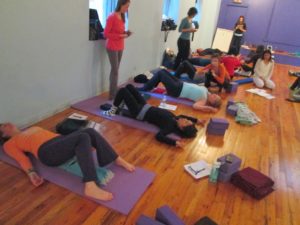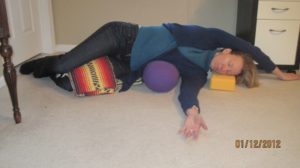
I am really out of the blogging habit after my summer hiatus. It was a complete whirlwind of a summer beginning with four trips to some high altitude places – Chicago skyline, British Columbia, Colorado and Switzerland. After almost two months of travel, I was ready to come home and find my roots. My vegetable garden and my flower gardens also found their roots while I was gone!
I gleaned so much from my Inner Peace Training programs this summer. Functional Yoga Therapy with Maria Mendola was a study in the body, how it moves and therapies to support it’s ease of movement. Studying intently with Neil Pearson and Lisa (Bergly) Pearson in Pain Care Yoga firmly rooted by interest and passion to help those with chronic pain. And finally the completion of my last residential Inner Peace program was the frosting on the top of the cake as well as the gooey insides. It has inspired me to become an intuitive healer working with my own energy and the energy of others. Switzerland was a good time of food, new friends and sights to delight eyes, ears, mouth, skin and nose.
One of the themes that came up for me in each of those programs and trips was intention. Without it, even Google Maps will not help me. It sets me up for success even if I fail because it is not narrowly focused, it is positive, and I believe in it. Deepak Chopra wrote this short piece on intention that I’d like to share with you – The 5 Steps To Harness the Power of Intention. https://www.mindbodygreen.com/0-9603/5-steps-to-harness-the-power-of-intention.html
One of the ways that we can set intention in our yoga practice is through a Sankalpa. Read on to learn how to set your Sankalpa for your practice, for your life.
Give your New Year’s resolutions a yogic twist—set an intention and infuse the new year with positive change.
A new year’s resolution is a noteworthy concept—start off the year with a change for the better. So how did it devolve into a subconscious exercise in self-loathing? Lose 10 pounds! (Message to self: You’re fat.) Stop drinking caffeine! (You’re unhealthy.) Call Mom and Dad once a week! (You’re ungrateful.) Why not celebrate this new year by trading in your tired (and probably familiar) resolutions for a sankalpa instead?
POSITIVE POWER A Sanskrit word, sankalpa means “will, purpose, or determination.” To make a sankalpa is to set an intention—it’s like a New Year’s resolution with a yogic twist. While a resolution often zeros in on a perceived negative aspect of ourselves (as in, “I want to lose weight, so no more chocolate chip cookies or ice cream or cheese”), a sankalpa explores what’s behind the thought or feeling (“I crave chocolate chip cookies or ice cream or cheese when I’m feeling stressed or sad. I will set an intention to become conscious of this craving and allow my feelings to arise and pass, rather than fill up on fats”).
EFFORT COUNTS A sankalpa also praises the nobility of the effort rather than focusing on what you are doing wrong. “New Year’s resolutions leave me feeling guilty and mad at myself for not keeping them,” says Wendy McClellan, a yoga teacher in Louisville, Kentucky. So, last year, in a conscious effort to reject the resolution rut, she taught a special New Year’s Eve yoga class and encouraged students to look back and let go. Her intention, or sankalpa? To open her heart to new possibilities. “An intention has much more of a global sense than a resolution,” she says. “It helps me be softer with myself.” With a sankalpa, the self-loathing that comes from dwelling on past transgressions can begin to dissolve. In its place is an exercise in effort and surrender—create an intention and open yourself to the universe.
Sankalpa Setting
LOOK INWARD For several days, set aside time to write in a journal and meditate. Mull over your typical resolutions. How do they make you feel? Anxious? Unsettled? Incomplete? Now contemplate how you would like to feel during the coming year. Is there any way you can reframe your results-oriented resolutions into something that will make this year’s journey more joyful and worthwhile?
REPHRASE IT Create a short sentence or phrase for your sankalpa. Be careful not to set limitations based on fear. For example, instead of “May life bring me only happiness and joy this year” consider “May I be happy and open to what life brings me.”
BE FIRM BUT FAIR Change doesn’t happen overnight. When you stray from the essence of your sankalpa, don’t berate yourself. Instead, gently remind yourself of your intention. But be firm in your resolve—it’s a good idea to incorporate your sankalpa into yoru daily routine. Use it as a mantra during pranayama or meditation practice; post it on your computer, phone, or mirror; or simply say it to yourself quietly before going to sleep. —C.G
Catherine Guthrie is a writer and yoga teacher in Louisville, Kentucky, and a regular contributor to Yoga Journal.
Breath (Pranayama)
3-Part Breath (Dirga Pranayama) – Expanding energy, circulation
Come to a comfortable seated or supine position, fully supported. Place hands on your belly and breathe in enough so that you feel the abdomen rise into your hand on the inhale and relax on the exhale. Stay with the awareness of the rise and fall of the belly for at least 4 breaths (Part 1 of Breath). Next, place the hands alongside your ribs. Inhale deeply to feel the belly rise and the ribs expand under your fingers. Exhale and feel those parts relax and release. At least 4 breaths here, (Part 2 of breath) slowly expanding the lungs. The final part of this 3-part breath, is to place the hands on the chest, below the collarbones. Breathe in to feel the belly expand, the ribs separate slightly and the chest lift into the hands – filled with light and openness. Exhale and witness the release of your body through the chest, ribs and belly. 4 breaths.
Poses (Asana)
Bridge Pose (Setu Bandhasana) & Variations for Spine Opening
(adding energy, vitalization)
Benefits: Expands the chest muscles, opens the lungs, balances the glands, quiets the nerves and releases tension in the nervous system, increases oxygen intake to the brain, can stimulate the immune system (thyroid)
Props: 4 blankets, neck roll, eye pillow, can also use bolster for more stretch
Extras: blanket for warmth
Lie on your back with knees bent and feet flat on the floor. Lift butt and slide the stack of 2 or 4 blankets under the base of your spine. Find a comfortable position, then let the upper back release on the floor. Arms are relaxed at sides or resting on belly. Feel chest and belly rise with each breath. Roll gently to one side when done and inhale up to seated.
Sublime Side Lean
Props: bolster, 2 or 3 pillows or blankets
Benefits: Stretches the torso and provides a gentle twist which allows a release in tension in the lower back area.
Lie on right side of bolster with hip at the base of it. Torso should rest on the stack. Right arm should be under the head. The left arm can reach over the head to increase the stretch. Close your eyes and allow your body to relax and release any stress or tension. Slowly sit up and switch sides for the same amount of time.
Focus on your breath. Breath into your right side allowing that gentle stretch to travel from the tip of your fingers down your lower spine. Sense the left side of your body gently melting and surrendering to the ground beneath you. All tension and stress being recycled by mother earth. Sense the gentle letting go of your muscles and knowing that you are safe and supported. Breath deep and exhale soft and long.
Grounding Version – extend legs so that feet touch the wall. Add extra blankets or bolster along spine to support your back. Cover with a blanket for extra comfort.





This is very interesting to read. Anyone can learn a lot from this article.